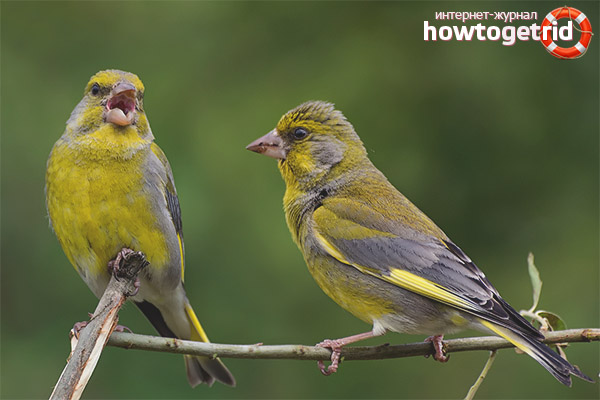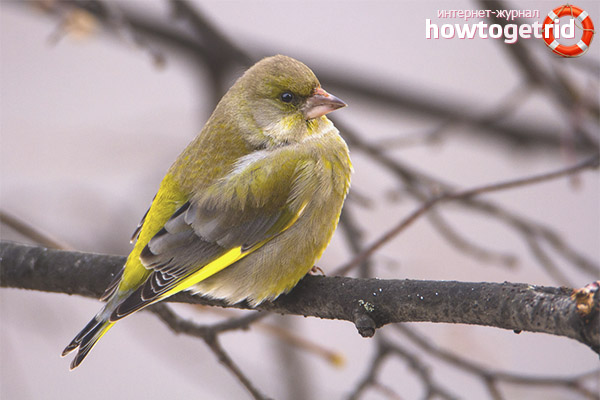The content of the article
Representatives of the genus Carduelis dwelling in glades are famous for common greenfinches. This little bird is distinguished by a perky trill, which gives everyone. Especially pleasant sometimes is spring, filled with a chime of bird polyphony. Singing greenfinch is so loud that it seems that it is she who awakens nature and encourages spring to change the winter cold. Everyone who has seen greenfinch will no doubt say that this bird stands out not only with its trills, but also with its glorious plumage. Although it was for the voice of a century ago that it was often called people a canary. However, the bird has nothing to do with this species, since it is rooted in the family finch. This fact is confirmed by numerous studies by ornithologists.
Bird description
The appearance of the bird correlates with its name, because it is the plumage of bright yellow and green shades that is characteristic of it, acquiring an olive tint in the sun, caused its name to appear. The usual "robe" for a bird often has a rim along the wings of contrasting yellow color.
By the size of the body, greenfinches belong to small-sized birds. For clarity, they are compared with sparrows, which they hardly exceed in size.
What other distinctive features are characteristic of birds of this species? Firstly, greenfinchs are owners of a rather large head, a thickened beak, painted in light colors, and a dense body. Secondly, the tail of the bird is narrowed and has a darker color. If we consider individual feathers, we can note the heterogeneity of the distribution of color over them: towards the end they become lighter. The iris of the bird’s eyes is painted in various shades of dark colors. The weight of an adult does not exceed 35 g, the length of the body often varies depending on the subspecies, in general, reaching 18 cm.
Bird distribution area
Representatives of this species participate in seasonal migrations, which are resorted to because of the need to wait out the winter season in the southern latitudes. As noted earlier, the singing of a bird distinguishes it from other birds. You can hear the voice of greenfinch in the first months of spring. However, the birds are most active in April and May, due to the onset of the mating season, which is important for any living organism. Musicality and melodiousness of singing is achieved by the bird through skillful alternation of trills, tweets and twittering. The length and sonority of the voice can create the impression that the greenfinch is in no hurry, singing monotonously.
The male begins the similar singing. In the morning hours, the male flies up to the highest branches of the nearby tree and loudly conducts its melody. To attract attention, trills and chirping of a bird are accompanied by take-offs that raise it above the foliage. In this way, the male demonstrates the diversity of plumage. If the birds eat, their roll call is a quiet whistle.
Nutrition and breeding features of birds

Food included in the diet of greenfinch indicates their unpretentiousness. The basis of the nutrition of birds is wheat germ popular among people who are fond of veganism.In addition, birds are happy to peck seeds, herbs and buds. Occasionally they pay attention to insects. If you come across a large seed, then before you eat it, representatives of this species will first carefully peel it, reducing it in size. If possible, the birds do not neglect the goodies, the favorite of which are juniper berries.
With the onset of spring, the birds begin to breed. Nest construction is done by females. Their birds are placed on trees. The main condition that the birds try to observe when choosing a place for the future nest is its remoteness from people. That is why nests of greenfinches can appear at about 5 meters from the surface of the earth. The shape of the nest is similar to a bowl woven from small twigs and roots, strewn with grass, leaves and moss. In the created nest, the female greenfinch lays eggs painted in light colors with brown spots, the number of which does not exceed 6 pieces. The incubation period of greenfinches takes about 14 days. The male is engaged in the food of the female. After the birth of the chicks, the extraction of food and the search for food falls on the shoulders of the male, too.
Bird flights
In March, the birds are preparing for the spring flight. In the habitats of populations of greenfinches during this period, loud trills are heard, signifying the rapid migration of birds. Throughout June and July, individuals group and flock to find food on the outskirts of cities where forests have grown and fields are spread.
The main flight is made by greenfinches, like other species, in the autumn. Typically, migration occurs in September or October. A rare case is flocks of birds, continuing the "journey" in the winter months. The main criterion for choosing a new habitat for birds is the amount of feed. During migration, the greenfinch experiences molt lasting for three months.
Life in captivity

There are precedents for catching greenfinches by people. Its resemblance to a canary and a sonorous voice often became the reason for detention in captivity. Gullible birds called “forest canaries” are easily tamed, live quietly in a cage. The period of adaptation of the bird to captivity lasts several weeks. Its end can be judged by the fact that the bird begins to sing. They adapt more easily if they live in a cage with other representatives of their species or other friendly birds that do not threaten the life and health of greenfinches. The peace-loving nature of the greenhouses themselves differ. They do not quarrel and easily get along with any neighbors.
The birds are fed with finely chopped fruits, cereals or mixtures of grains, seeds of plants, as well as berries. Note! It is important that feathered pets always have clean and fresh water, as it is an essential component in normalizing the digestive system.
On average, birds live long - greenfinch lifespan reaches 8 years. However, this directly depends on the quality of the conditions that the owners create for the bird living under their supervision. If you take care of the bird, without neglecting the important rules, it will be able to please you for 12 years.
Interesting Facts
- In the natural habitat, several subspecies of greenfinchs can be distinguished. At the moment, scientists count eight.
- After the chicks become stronger, the female changes the nest. Therefore, after 20 days, she begins to build a new "place of stay." During this period, the male nurses the chicks.
- In the natural environment, greenfinches have enemies. A small bird is endangered by ravens, which destroy nests and destroy offspring, preventing him from being born.
Video: common greenfinch (Carduelis chloris)










Submit